 |
|

|
Seaweek
Discoveries in Victoria's Marine National
Parks
and Marine Sanctuaries (cont)
courtesy
Parks Victoria |
|
|
|
Vermilion
Seastar
Pentagonastar dubeni
This handsome seastar sports a deep
red to orange armour plated coat with
a mosaic pattern that helps protect
it from predators. Moving on slender
tube feet with tiny suckers at the
end of each one, these seastars are
often assocaited with sponges and
rocky reefs.
Seastars
are related to sea urchins, brittle
stars and sea cucumbers. This seastar
eats by pushing its stomach out of
its mouth and digesting the food outside
of its body. When finished it sucks
its stomach back in through its mouth.
|
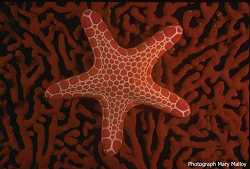 |
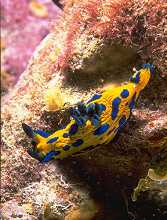 |
Verco's
Nudibranch
Tambja verconis
Nudibranchs or sea slugs are beautiful
brightly coloured animals. The name
refers to the feathery naked gills
on their backs. Growing to 13cm in
length they move around like a common
garden slug.
Living
on sponges and other animals, Verco's
Nudibranch feeds on green colonies
of moss animals known as Bugula. Their
striking colours and poisonous bodies
deter fish from eating them. 400 species
of nudibranchs are found Australia
wide in habitats such as rockpools
and sponge gardens.
|
| |
|
|
Southern
Hermit Crab
Trizopagurus strigimanus
Hermit crabs are eccentric creatures
that protect their soft tail by living
in old snail shells. A scavenger,
hermit crabs feed on the remains of
both plants and animals. They can
grow to about 12cm in length.
Crabs
carrying eggs are said to be 'in berry'.
Hermit crabs hide their eggs in a
pouch on their bodies, inside the
shell. Their eggs hatch into planktonic
larvae and eventually settle to the
sea floor and look for snail shells,
sometimes battling each other for
the ideal home. Hermit crabs are found
on rocky reefs in Southern Australia's
temperate waters.
|
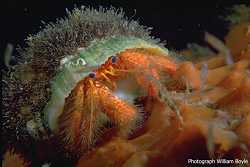 |
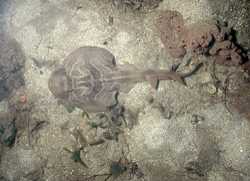 |
Southern
Fiddler Ray/Banjo Shark
Trygonorrhina fasciata
A
long tailed ray with beautiful markings
that is shaped like a Banjo. Its head
and body are flat with eyes on top
and mouth and nostrils below. Related
to the Eagle Ray and Sting Ray they
grow to 120cm, are placid and harmless,
and live in shallow waters such as
those of bays and estuaries.
Banjo
Sharks have no teeth, instead using
bony plates to crush shellfish and
crabs. They give birth to live young
and have very few predators apart
from humans. Found in mudflats, bays
and estuaries.
|
| |
|
|
Southern
Pot-bellied Seahorse
Hippocampus abdominalis
There are few things more graceful
and intriguing to watch than the courtship
dance of Seahorses. An elegant glider
through water, the male Pot Bellied
Seahorse has a brood pouch in which
the female lays their fertilised eggs.
After a month or so, dad gives birth
to up to 100's of live young that
look like miniature versions of their
parents
Seahorses posses long tubular mouths
which 'suck in' unsuspecting small
crustaceans. They use their tales
to hold on to vegetation. The capture
of wild seahorses for use in the traditional
Chinese medicine trade and habitat
loss threaten the future of this most
unusual fish.
|
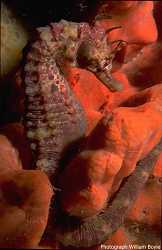 |
|
|
|
|
|
